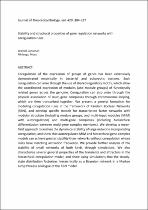 ResearchSpace
ResearchSpace
Stability and structural properties of gene regulation networks with coregulation rules
JavaScript is disabled for your browser. Some features of this site may not work without it.
- ResearchSpace
- →
- Research Publications/Outputs
- →
- Journal Articles
- →
- View Item
| dc.contributor.author |
Warrell, Jonathan

|
|
| dc.contributor.author |
Mhlanga, Musa

|
|
| dc.date.accessioned | 2018-07-02T08:45:40Z | |
| dc.date.available | 2018-07-02T08:45:40Z | |
| dc.date.issued | 2017-05 | |
| dc.identifier.citation | Warrell, J. and Mhlanga, M. 2017. Stability and structural properties of gene regulation networks with coregulation rules. Journal of Theoretical Biology, vol. 420: 304-317 | en_US |
| dc.identifier.issn | 0022-5193 | |
| dc.identifier.issn | 1095-8541 | |
| dc.identifier.uri | https://www.sciencedirect.com/science/article/pii/S0022519316303381 | |
| dc.identifier.uri | https://doi.org/10.1016/j.jtbi.2016.10.020 | |
| dc.identifier.uri | http://hdl.handle.net/10204/10285 | |
| dc.description | Due to copyright restrictions, the attached PDF file only contains the abstract of the full text item. For access to the full text item, please consult the publisher's website. | en_US |
| dc.description.abstract | Coregulation of the expression of groups of genes has been extensively demonstrated empirically in bacterial and eukaryotic systems. Such coregulation can arise through the use of shared regulatory motifs, which allow the coordinated expression of modules (and module groups) of functionally related genes across the genome. Coregulation can also arise through the physical association of multi-gene complexes through chromosomal looping, which are then transcribed together. We present a general formalism for modeling coregulation rules in the framework of Random Boolean Networks (RBN), and develop specific models for transcription factor networks with modular structure (including module groups, and multi-input modules (MIM) with autoregulation) and multi-gene complexes (including hierarchical differentiation between multi-gene complex members). We develop a mean-field approach to analyse the dynamical stability of large networks incorporating coregulation, and show that autoregulated MIM and hierarchical gene-complex models can achieve greater stability than networks without coregulation whose rules have matching activation frequency. We provide further analysis of the stability of small networks of both kinds through simulations. We also characterize several general properties of the transients and attractors in the hierarchical coregulation model, and show using simulations that the steady-state distribution factorizes hierarchically as a Bayesian network in a Markov Jump Process analogue of the RBN model. | en_US |
| dc.language.iso | en | en_US |
| dc.publisher | Elsevier | en_US |
| dc.relation.ispartofseries | Worklist;20316 | |
| dc.subject | Random boolean networks | en_US |
| dc.subject | Mean-field approximation | en_US |
| dc.subject | Network motifs | en_US |
| dc.subject | Stochastic gene expression | en_US |
| dc.subject | Markov jump processes | en_US |
| dc.title | Stability and structural properties of gene regulation networks with coregulation rules | en_US |
| dc.type | Article | en_US |
| dc.identifier.apacitation | Warrell, J., & Mhlanga, M. (2017). Stability and structural properties of gene regulation networks with coregulation rules. http://hdl.handle.net/10204/10285 | en_ZA |
| dc.identifier.chicagocitation | Warrell, Jonathan, and Musa Mhlanga "Stability and structural properties of gene regulation networks with coregulation rules." (2017) http://hdl.handle.net/10204/10285 | en_ZA |
| dc.identifier.vancouvercitation | Warrell J, Mhlanga M. Stability and structural properties of gene regulation networks with coregulation rules. 2017; http://hdl.handle.net/10204/10285. | en_ZA |
| dc.identifier.ris | TY - Article AU - Warrell, Jonathan AU - Mhlanga, Musa AB - Coregulation of the expression of groups of genes has been extensively demonstrated empirically in bacterial and eukaryotic systems. Such coregulation can arise through the use of shared regulatory motifs, which allow the coordinated expression of modules (and module groups) of functionally related genes across the genome. Coregulation can also arise through the physical association of multi-gene complexes through chromosomal looping, which are then transcribed together. We present a general formalism for modeling coregulation rules in the framework of Random Boolean Networks (RBN), and develop specific models for transcription factor networks with modular structure (including module groups, and multi-input modules (MIM) with autoregulation) and multi-gene complexes (including hierarchical differentiation between multi-gene complex members). We develop a mean-field approach to analyse the dynamical stability of large networks incorporating coregulation, and show that autoregulated MIM and hierarchical gene-complex models can achieve greater stability than networks without coregulation whose rules have matching activation frequency. We provide further analysis of the stability of small networks of both kinds through simulations. We also characterize several general properties of the transients and attractors in the hierarchical coregulation model, and show using simulations that the steady-state distribution factorizes hierarchically as a Bayesian network in a Markov Jump Process analogue of the RBN model. DA - 2017-05 DB - ResearchSpace DP - CSIR KW - Random boolean networks KW - Mean-field approximation KW - Network motifs KW - Stochastic gene expression KW - Markov jump processes LK - https://researchspace.csir.co.za PY - 2017 SM - 0022-5193 SM - 1095-8541 T1 - Stability and structural properties of gene regulation networks with coregulation rules TI - Stability and structural properties of gene regulation networks with coregulation rules UR - http://hdl.handle.net/10204/10285 ER - | en_ZA |





